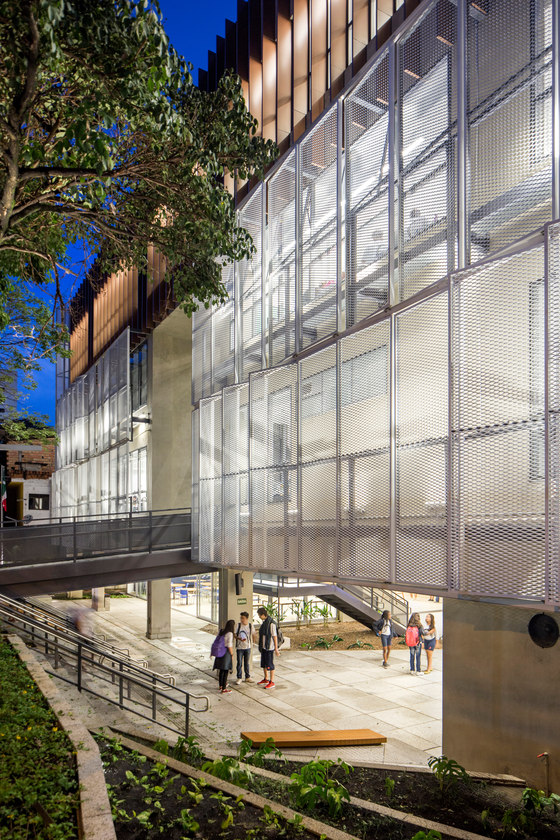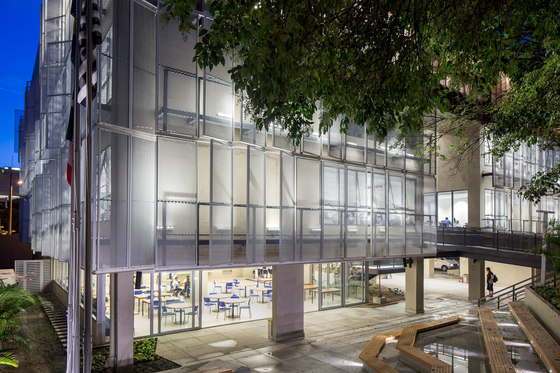The new Bradesco Foundation High School was inaugurated in Osasco, nearby São Paulo Brazil. Designed by Shieh Arquitetos Associados, office with over 40 years of practice and focus on educational architecture, the project converted an administrative building originally occupied by Bradesco bank into a school compatible with the high principles of the Institution.
The proposal sought to make the most of the existing structure while using constructive resources that could give new character and life to the building, in order to accommodate educational facilities. Some of these strategies were the inclusion of facade pre-shading for thermal comfort and diffuse light filtering in classrooms, adoption of large vertical atria, new internal stairs, new entrance walkway, lower ground floor converted as large patio and garden, among others.
Plans were organized to solve some of the challenges imposed on a vertical building: large flow of students and limitation of patios. Hence, classrooms were organized on the lower floors – except for the ground floor, which is dedicated to arrival patio and cafeteria.
The first floor accommodates 7 classrooms, while the second includes another 10, totaling 17 classrooms. Special rooms (library, laboratories and study rooms) were allocated on the upmost floor, considering that the flow to these spaces is rather smaller. The library, with all its symbolism inside an educational institution, is located on the topmost floor at the front façade of the building – as if the library was leaning over the front street and as if people were invited to enjoy the institution.
The lower ground floor is treated as a "Arrival and Conviviality Patio" of all students, whether coming from the street or school van. Since this patio is sunken below street level, the design offers a small arena to the students, with benches adjacent to cafeteria and internal patio. With the partial demolition of two stretches of front slabs, it was possible to create large central atria that aerate vertically the existing building. These atriums, covered by sheds of illumination and ventilation, and open laterally, also provide abundant circulation of air by cross ventilation and chimney effect.
Another key point is the suitability of vertical circulations. Taking advantage of the open atria, two new and prominent stairs were created, allowing the demolition of the existing staircase. To allow access of wheelchair users into the building, the project replaced an existing steep concrete walkway, by a new steel ramp that goes deeper into the building.
This new walkway gives direct access to the first floor of the building – which includes the school's administrative rooms. Thus, it is understood that parents of students, staff and visitors will use this walkway instead of descending by staircase to the ground floor – main access to the students.
Along the 3 upper floors, classrooms and special uses occupy the perimeter areas and release large central portion of the project's slab, nicknamed "Aerial Patios" – characterized by two large voids and vertical circulations. Seen from the Aerial Patios, the classroom walls are special pieces, with continuous upper glass strip and air circulation slot with chicane for sound absorption. In plan, the organization of the classrooms generated unusual angles, mainly due to the position of the existing emergency stairs. These very angles are highlighted through the new wood-veneered walls with recessed blackboard, shaped as benches and tables.
It is important that the furniture entice students to appropriate themselves of the Aerial Patio, in a manner to compensate the small site available. These opportunities for interaction directly reflect on educating through companionship. The existing building, stripped of its external masonry, gives way to large glazed panels – now protected by an extra layer of expanded aluminum sheet and louvers.
Placed 75cm away from the existing façade, the expanded white aluminum sheet has two functions: to filter direct light in a homogeneous, high-quality ambient light to classrooms, and to pre-shade the building to minimize thermal gain. This avoids the so-called "iced tea dilemma" which expects the building to gain heat and then spend energy to treat its cooling. This system of the facade is divided into articulated modules, which provides a better orientation in relationship to the sun, and facilitates maintenance and cleaning.
The expanded aluminum sheet system is fixed through an auxiliary metal structure that also supports a catwalk, which serves as a continuous technical gallery for cleaning and maintenance. This interstice between two facades also accommodates equipment, in particular air conditioning.
Critical question in schools, acoustic performance of the building was given special attention in the project. Inside the classrooms, the teacher needs both the reflective surfaces to make themselves heard, but also needs absorbing surfaces for noise. The solution adopted by the office was the adoption of alternating "lanes" of gypsum board ceiling, plain and perforated.
Shieh Arquitetos Associados
Shieh Shueh Yau, Leonardo Shieh, Irene Shieh (Authors), Karen Minoda, Nathália Grippa, Ricardo Azevedo, Yuhu Minami, Juliana Stendard, Thiago Peng (Team)
Contributors: Lenita Pimentel (Estúdio Casa 64)
Founded: MG & A
Air-Conditioning, Exhaust and Ventilation: Thermoplan
Structure: Prodenge
Electrical and Hydraulic: PHE Projects
Frames: Dinaflex
Visual Communication: João Nitsche (Nitsche Arquitetos)
Landscaping: Rosa Kliass and Luísa Mellis
Lighting Design: Franco Associados Lighting Design
Interiors: Shieh Arquitetos Associados
Acoustics: Sresnewsky Acoustics and Technology
Sustainability: Jörg Spangenberg
Manager Work: Metroll
Builder: Inova TS







































